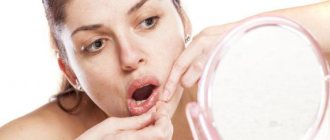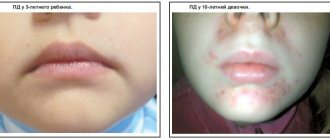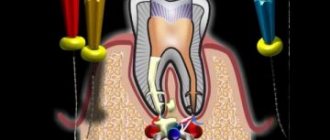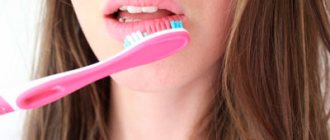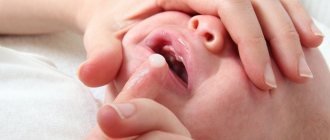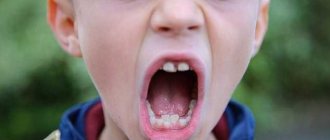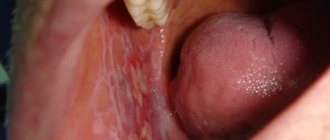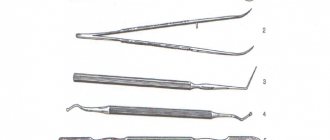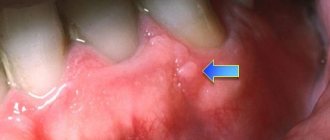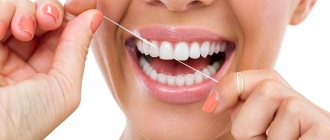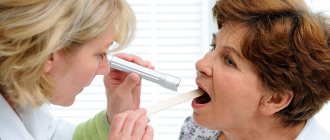Causes of redness in the corners of the lips in adults and children
If the corner of your lips turns red, this may indicate:
- lack of vitamins in the body;
- depressed immunity;
- diabetes;
- chronic intestinal pathologies;
- diseases of the nervous system;
- damage to the oral cavity by yeast-like fungi or streptococcal infection.
The oral mucosa is characterized by increased sensitivity to the effects of negative factors.
Therefore, redness of the corners of the lips can also lead to:
- frequent licking;
- prolonged course of dental pathologies (caries, inflammation of periodontal tissue);
- sudden change in climatic conditions;
- negative environmental impacts (cold wind, heat, etc.);
- incorrect bite, due to which the corners of the lips are damaged during a conversation.
Severe stress and prolonged use of hormonal and antibacterial drugs can lead to redness. Cheilitis also develops due to the action of allergens on the skin.
Seasonal vitamin deficiency
Regardless of the nature of peeling in the corners of the lips, the reasons for the appearance of such a symptom often lie in a lack of vitamins in the body. Moreover, most people experience such problems at certain times of the year - at the end of winter and beginning of spring.
During this period, the body experiences an acute shortage of beneficial microelements due to a shortage of fresh vegetables and fruits on the market. Insufficient consumption of vitamins C, A and P causes dryness of the dermis in the corners of the mouth, and vitamins B1, B6, B12 and PP cause cracks in these areas of the lips.
Lack of vitamin B2 in the body
Vitamin B2 (riboflavin) is involved in oxygen transport processes. A deficiency of this element negatively affects the condition of the entire body.
Riboflavin deficiency causes not only redness in the corners of the lips, but also peeling of the epidermis, dysfunction of the nervous system and slower regeneration of damaged tissues.
Habit of licking lips
Frequent lip licking is another common reason why cheilitis occurs. This habit causes the skin to dry out quickly. As a result, lips begin to peel and crack.
More often, the habit bothers people in frosty or hot weather, as well as in vitamin deficiencies. Under these conditions, the skin on the lips dries quickly, and regular licking eliminates the problem for a short time.
However, such exposure irritates the corners, which leads to the development of cheilitis.
Diagnostics by eyes
If you look carefully into our “mirror of the soul,” you can unmistakably recognize not only your mood and true intentions, but also signs of various problems in the body. Yellowish sclera (whites) of the eyes “signal” about liver problems. If this occurs suddenly, is combined with general jaundice of the skin, fever and brown urine, this is almost 100% hepatitis A (jaundice).
Go to the hospital immediately! If the eyes are constantly yellow, it means that the liver cannot cope with the load. This happens with chronic inflammation of the liver and gallbladder, cirrhosis. You need to take blood tests - general and biochemistry, and also do liver tests. Eyes become watery with inflammatory diseases of the eyelids (blepharitis, conjunctivitis), with infection of the paranasal sinuses (sinusitis).
Watery eyes from one eye and swelling of the area around it may be a sign of advanced pulpitis (inflammation of the soft tissues of the tooth). Tight bags on the lower eyelids are a sign of heart failure or kidney problems. Large and flabby bags with bluish veins indicate an avid drinker. Swollen upper eyelids can be one of the external symptoms of cerebral vascular sclerosis. Protruding eyes (bilateral exophthalmos) are a clear sign of problems with the thyroid gland, including a manifestation of Graves’ disease. If the eyeball protrudes on one side, it may be a sinus cyst or the formation of a tumor. Narrow pupils in normal lighting indicate that a person is suffering from some kind of severe pain. Also, constricted pupils are characteristic of drug addicts who use opium derivatives. Different colored eyes (for example, one is blue, the other is brown) is a congenital pigmentation disorder.
We suggest you read: How to get rid of toothache, and what helps with it?
This is just a piquant feature that does not affect vision. Both pupils are evenly wide in some forms of myopia. Such a reaction is possible during a hypertensive crisis. Very wide pupils, almost unresponsive to light, are typical when using atropine-based drugs. Eye twitching - a nervous tic - is a sign of developing neurosis. This may also indicate neuralgia of the facial nerves. Unilateral tics often occur with migraines. Eyelashes can tell you something about your health.
For example, very long and fluffy ones indicate a congenital tendency to bronchopulmonary diseases, including tuberculosis and bronchial asthma. Loss of eyelashes signals a general decrease in immunity and a lack of B vitamins. If the eyes turn red and tears begin to flow in three streams as soon as a person smells a flower or strokes a cat, then we can safely talk about an allergic reaction. Drooping corners of the eyes are a sign of prolonged depression. Frequent blinking is a symptom of neurosis (this is especially common in children). An unblinking gaze, directed as if through the interlocutor, is a distinctive feature of a serious neuropsychic disorder associated with apathy and “withdrawal.” Redness of the eyeballs, coupled with inflamed eyelids, indicate a person suffering from chronic insomnia. Vessels in the eyes burst when the eye muscles are overstrained, as well as due to changes in intracranial pressure
Text: Ekaterina Eliseeva based on materials from the book by Vistara G. Gaiduk. “Diagnostics by face” (Vistara H. Haiduk: Gesichtsdiagnose)
Acne, like bags under the eyes, can tell a lot about the state of our health. But a disease is always easier to prevent than to treat. To find out whether you have a tendency to a particular disease, sometimes it’s enough to look carefully in the mirror.
Please note that the information below should in no way serve as an alternative to visiting your doctor. This is just a reason to think about your health and the health of your loved ones, balance your diet and start leading a healthy lifestyle.
Symptoms and methods for diagnosing diseases
Peeling skin at the corners of the lips does not indicate a specific problem. At the same time, in order to cure cheilitis, it is necessary to identify the causative factor. The nature of the latter is indicated by accompanying symptoms that occur simultaneously with skin hyperemia.
- In case of recurrence of herpetic infection, the patient is concerned about the following clinical phenomena:
- edema;
- itching;
- burning;
- blistering rashes with serous fluid;
- ulcers.
- Infection with streptococcal infection is indicated by the appearance of vesicular neoplasms, the upper layer of which is lined with epithelium. After such growths are opened, erosions remain in their place, eventually becoming covered with a purulent crust. During this period, the patient experiences intense pain that interferes with eating and talking.
- With candidiasis , caused by infection with the yeast-like fungi Candida, a white coating appears in the affected area. Healthy skin remains untouched. Plaque hides bleeding ulcers.
- Against the background of primary syphilis, neoplasms sometimes develop in the corners of the lips with a red surface. In this case, an ulcer with a dense, gray shell forms on the problem area.
- The development of the inflammatory process is caused by an allergic reaction caused by food, if the corners of the lips are red, there is itching and swelling, but after 1-2 days no blistering rashes appear in the problem area.
- Against the background of nervous overstrain, the above symptoms characteristic of cheilitis also occur. In such circumstances, identifying the true cause of the development of redness is quite difficult. Severe stress, like vitamin deficiency, gastrointestinal pathologies, dermatitis and an allergic reaction, causes peeling and redness of the skin in the corners of the lips.
- We can talk about damage to the salivary glands if the symptoms described above occur with the appearance of aching pain. The course of the inflammatory process is accompanied by the formation of red spots on the lip.
Most pathologies that provoke the appearance of these clinical signs are distinguished by characteristic symptoms. Therefore, treatment of redness and cracks in the mouth is often prescribed based on data from an external examination of the patient.
If necessary, an assessment of the person’s immune status and examination of the gastrointestinal tract are carried out.
Causes of dark spots on lips
Pigment spots that appear on the lips can vary in color, size, shape, rise above the surface of the skin or be flush with it (see photo).
Experts advise paying attention to such reactions of our body, especially if blue or black pigmentation is present. Such spots almost always indicate a serious malfunction in the human body.
Among the main causes of stains are:
- side effect from taking medications and hormonal drugs,
- wrong choice of cosmetics,
- burns,
- harmful effects of sunlight,
- presence of hyperpigmentation.
Reaction to medications
Medicines are prescribed exclusively by a qualified doctor and taken in accordance with the instructions. However, this does not guarantee the absence of side effects after taking the drug. Darkening around the lips is one of the manifestations of a negative reaction. For example, acne around the lips may indicate abuse or long-term use of hormonal medications.
Low-quality cosmetics
The wrong choice of cosmetics is the cause of stains around the lips. Many cosmetics (lipsticks in particular) contain oils, which, by clogging pores, prevent the skin from breathing. This leads to the appearance of blackheads. Before purchasing cosmetics, you need to carefully study its composition and eliminate harmful effects on the skin.
Burns
Another cause of stains around the mouth is burns. When burned, the skin loses its elasticity, forming scars and losing its natural pigmentation. This will cause discoloration of the skin around the lips and the possibility of blemishes. The defect is cosmetic and can be removed by surgery.
UV exposure
A bronze tan is beautiful, but you need to tan wisely. When going to the beach, we protect our skin from the harmful effects of sun rays with special creams, our head and eyes with a hat and sunglasses, but we do not care about protecting our lips, which are also exposed to the harmful effects of UV radiation.
Before going out in the sun, you need to use lip balms with protective properties. Products containing UV filters are suitable.
In addition, there are people who suffer from skin hypersensitivity to ultraviolet radiation. In this case, there is no way to do without protective creams and balms.
Presence of hyperpigmentation
Hyperpigmentation can indicate many disorders in the body. For example, bluish spots around the lips indicate that the patient has problems in the “female” part. Hyperpigmentation often occurs during pregnancy.
Also, blue spots around the mouth sometimes indicate problems with the liver and adrenal glands, thyroid gland and gastrointestinal tract. It is possible that skin rashes are caused by heredity or skin trauma, such as burns. Often, the problem of hyperpigmentation occurs in girls who abuse solariums.
Hyperpigmentation in its early stages can be quickly treated. If you find spots above your lips, contact a specialist immediately.
Other factors
Other factors that influence the appearance of dark spots around the mouth include heredity. Peutz-Jeghers syndrome is a very serious disease in which large polyps form in the human intestine. Dots on the lips are the main symptom of this disease. Most often, the disease is inherited.
Also, dots on the lips or in the corners of the lips may indicate the presence of parasites in the body. Worm infestation also manifests itself as dark spots around the lips.
Another factor is old age. Often, in older people, so-called “venous lakes” appear in the lip area. They occur as a result of prolonged exposure to the sun. Diseases of the internal organs and cancerous growths may appear as spots around the lips or a dark spot inside the lip.
How to treat cheilitis on the lips with creams and ointments
When the skin in the corners of the lips cracks and peels, it is important to find out the cause as soon as possible. For quick treatment, you need to quit smoking, give up other bad habits and take into account the characteristics of your skin when selecting medications.
Failure to comply with the last rule may cause an allergic reaction, due to which the redness will worsen.
Complicated and prolonged cheilitis is treated with corticosteroid ointments:
- 0.5 percent prednisolone ointment;
- 1 percent hydrocortisone ointment;
- Mikozolon (prescribed for fungal infections);
- Flucinar.
Corticosteroids quickly suppress the inflammatory process and eliminate allergy symptoms, but such ointments are not recommended for use in cases of bacterial tissue damage.
Brown contour around the lips. self-diagnosis: symptoms of diseases on the face
A bluish shadow in the inner corner of the eyes: the weak point of the body is the kidneys. “Bags” under the eyes: the urinary system may be out of order. The lower part of the face (with lips) signals the state of the cardiovascular and respiratory systems. The way your cheekbones and nose look depends on your gastrointestinal tract.
The area around the eyes signals diseases of the genitourinary system. Dark circles under the eyes: it is quite possible that the liver is overloaded. But sometimes this can be a consequence of very thin skin through which the capillaries are visible. Peeling, especially around the nose, can have several causes: 1. The tan is fading. 2.
We invite you to familiarize yourself with Small salivary gland cyst
In summer, skin type often changes and normal skin becomes dry and flaky. 3. In men, it may be a prerequisite for psoriasis. Early double chin, loose skin: problems with the endocrine system are likely. Puffiness above the cheekbones: problems in the lymphatic system of the gastrointestinal tract are possible.
In men, this can sometimes be a sign of frequent “libation.” Rash on the temples: there is a possibility of problems with the gallbladder. Brown spots. Pigmentation is often caused by ultraviolet radiation and will not go away on its own. Stains can only be removed by a dermatologist. In men, they can also indicate the presence of hormonal problems.
Small white dots. Metabolic disorders are possible, but more often they arise from poor skin cleansing and blockage of the sebaceous glands. Red shapeless spots. Allergic reaction to food, cosmetics or clothing; sometimes occur against the background of prolonged stress or after prolonged colds. Yellowing.
Almost always talks about problems with the liver and gall bladder - you need to urgently consult a doctor. Red vascular network. Most often this is a consequence of a sharp temperature change, but sometimes it indicates the poor condition of blood vessels throughout the body; watch your blood pressure! Acne.
At a young age, acne occurs due to the immaturity of the endocrine system, and at a more mature age (after 25 - 28 years) - due to poor skin cleansing. Men can get infections when shaving. White spots. They usually appear not on the face, but on the neck, chest, and shoulders and are called vitiligo. Doctors do not yet know exactly where this disease comes from and how it is treated, but most doctors consider vitiligo to be a manifestation of nervous strain.
Folk remedies and home recipes
Folk remedies for combating redness in the corners of the lips can eliminate the symptoms of the disease that caused cheilitis, but not the pathology itself.
- to cope with redness in the tissues around the mouth . The liquid should be lubricated on problem areas several times a day.
- Rosehip, avocado, tea tree, and sea buckthorn oils have a milder effect These agents suppress bacterial microflora and stimulate tissue regeneration.
- To treat cracks in the corners of the lips, you can use an ointment prepared from boric acid (1 tsp), glycerin (2 tbsp) and raw yolk. After eating, it is recommended to apply pork fat mixed with honey in a ratio of 1 to 2 to problem areas.
- to combat bacterial microflora . The product should be applied to the damaged corners of the lips up to three times a day.
Redness in the mouth area occurs for many reasons. Most of them are associated with weakened immunity. In the treatment of cheilitis, a complex of drugs is used that eliminate inflammation and redness of the skin, as well as treat concomitant diseases.
Changes in weather, disruptions in the body - all this can provoke unexpected manifestations on the face. These “effects” include cracks in the corners of the mouth (angular cheilitis), which worsen in winter and cold autumn. They are in no hurry to disappear, since the reason may not be simple. The secondary appearance of jams requires serious treatment.
Treatment of irritation and dryness in the corners of the lips in adults
Treatment of cheilitis, like any other pathology, begins with eliminating the causative factors. After this, depending on the etiology and manifestations, the following are used:
- medical antiseptics;
- antibacterial, antifungal agents;
- anti-inflammatory, wound-healing drugs;
- other medicines.
Antiseptics
They are necessary for cleansing the affected area, which is performed before applying medicinal compounds.
The following are usually used as disinfectants for cheilitis:
- hydrogen peroxide;
- Chlorhexidine and Miramistin;
- pink solution of potassium permanganate.
Other compounds are also used as disinfectants.
One of these is Stomatidin, which is indicated for the treatment of dental and ENT pathologies. In addition to the antibacterial and antifungal effect, it has a calming and local analgesic effect.
Ointments can also act as antiseptics - sulfur-tar, zinc and others. The use of disinfectants is an important measure to prevent the spread of the infectious process.
Ointments for healing cracks
In the treatment of cheilitis, they are perhaps the main means of therapy, and the drugs differ in composition and action.
- Corticosteroid ointments contain artificial hormones that eliminate inflammation and relieve local allergic symptoms. External hormonal-based preparations are:
- single-component, that is, with one main component, such as Hydrocortisone, Prednisolone and others;
- combined, where in addition to corticosteroids there are antibacterial and antifungal components (Oxycort, Mycozolon, and so on).
- Ointments with antibacterial, antifungal and antiviral action. They are indicated for lesions of infectious etiology.
To choose the right remedy, it is important to know the type of pathogen:
- to combat pathogenic bacteria, compositions based on tetracycline, erythromycin or other antibiotics are used;
- Acyclovir, Gerpevir, oxolinic ointment are used as antiviral agents;
- For antifungal treatment, Clotrimazole, Lamisil, Pimafucin are prescribed, depending on the type of pathogen.
- Ointments with anti-inflammatory and wound-healing effects. Methyluracil is considered one of the most effective and inexpensive. It relieves inflammation, helps restore damaged epithelium, and improves local immunity. Can be used in combination with other drugs.
In order not to make a mistake in choosing an ointment for the treatment of cheilitis, you should consult a doctor.
Vitamins and microelements
For pathologies caused by vitamin deficiency, multivitamin complexes are recommended, which also contain vital minerals. Such products restore the balance of microelements and strengthen the immune system. Most often, Multi-Tabs and Complivit are prescribed.
Causes and contributing factors for the appearance of cracks
The first reasons for the development of cracks in the corners of the mouth are red spots in the corners of the lips. Soreness will follow.
The appearance of cracks is influenced by various factors. They are infectious, traumatic or fungal in nature, etc.
Traumatic
A wound on the edges of the lips occurs after a visit to the dentist. If the doctor used the instruments aggressively, then damage will not be long in coming. With frequent visits to the dentist, angulitis does not have time to drag on. Problems are often observed with constant wearing of a prosthesis.
It is the corners of the lips that suffer due to friction of the structure. If the lips are prone to dryness, clefts occur when screaming, yawning, or passionate kissing. You can find out the cause of such a seizure by remembering a recent trip to the doctor.
Infectious
Injury due to improper hygiene. With chronic trauma to the corners of the mouth, infections occur. Whether children or adults, everyone can be affected by the germ. This is facilitated by a reluctance to wash hands and put dirty objects in the mouth. Those who do not brush their teeth often experience angular wounds.
If dirt gets on your lips, the inflamed area becomes crusty and begins to bleed. Almost always the wound goes to the pharynx and chin.
Fungal infections
Candidiasis on the corners of the mouth is called “yeast infection” among specialists. Fungi multiply after a recent cold, diabetes, and gastrointestinal pathologies.
Long-term use of antibiotics also contributes to their occurrence. In this case, whitish erosion is observed, the plaque from which is removed by scraping.
Initial manifestations of syphilis
With this disease, a hard lump is disguised as cheilitis. This is an element of the initial stage of the disease. If left untreated, it will turn into secondary syphilis.
Angulitis becomes covered with a grayish coating without pain when touched. When a streptococcal infection occurs, the chancre becomes painful even when opening the mouth. A thickening occurs in the affected area.
Tuberculosis
Adult patients sometimes develop clefts in the corners of the lips. It signals active pulmonary tuberculosis. The person’s condition is serious, so such manifestations do not attract attention.
In this case, the ulcer on the corners of the mouth will be painful with undermined edges. The condition is unsatisfactory.
Bad habits
The appearance of clefts in the corners of the mouth is caused by habits such as licking, drinking alcohol, and smoking. In addition, regularly keeping foreign objects in the oral cavity contributes to the development of angular stomatitis.
With uncontrolled consumption of strong drinks, the body is weakened, which provokes an exacerbation of diseases in remission. They also affect the integrity of the skin. After stopping bad habits, seizures stop appearing.
Main causes of hyperpigmentation
The appearance of spots in the corners of the lip is the result of an increase in melanin in some areas of the epidermis. The reasons for the appearance of dark spots on the surface of the lip or in its corners lie in the excessive production of melanin. And the production of pigment can be triggered by sun rays, inflammatory processes, and melasma.
Most often, a dark area on the surface of the lip appears due to prolonged exposure to the sun. This does not mean at all that immediately after contact with ultraviolet light the corners of the mouth will darken. Sometimes it may take more than one month or even more than one year for such a problem to appear. Therefore, it is recommended to use sunscreen on your face before going outside.
Darkening of the lips under sun exposure can occur in both adults and children.
Another reason why the lower lip or upper lip turns black is melasma or chloasma. Such darkening is usually symmetrical; they can appear on the surface of the forehead, above the lips, and on the cheeks. Hormonal dysfunctions during pregnancy and during the use of hormonal oral contraceptives can provoke the appearance of dark spots around the lip. This form of hyperpigmentation is permanent. Even after treatment, spots tend to reappear after a while.
After inflammatory diseases of the skin, consequences such as post-inflammatory hyperpigmentation often appear. More often this phenomenon is observed in dark-skinned people. This problem occurs in the area of healing of burns, acne or other damage to the integrity of the skin. In this case, the darkening usually goes away on its own six months after its appearance.
The influence of climatic conditions is also important. During the cold season, the skin becomes drier. The situation is aggravated by frequent licking of the lips, which entails the appearance of dark areas around the mouth. In this case, you should use an intensive moisturizing cream.
It is recommended to consult a dermatologist, since this problem may be evidence of skin cancer in the early stages, as well as other dangerous diseases. Therefore, it is better to visit a doctor and dispel doubts. A dermatologist can also advise on the most optimal methods for eliminating dark spots.
Treatment
The method of treating angulitis depends on the reasons that provoked its appearance. What to do in the event of the development of a serious pathology - to treat yourself or go to a doctor - is decided by the person himself. In the absence of proper treatment, cheilitis can turn into purulent abscesses.
- Trauma, bad habits. Correct the prosthesis, temporarily avoid going to the dentist, do not perform active actions with the throat and lips, take proper care of the oral cavity, and brush your teeth thoroughly. It is recommended to numb the surface with lidocaine-based solutions. Treat with antiseptics, stimulate healing with rosehip or sea buckthorn oils. It is also not forbidden to use cream for dryness and flaking.
- Leukoplakia. Stop smoking, eliminate spicy foods from your diet. For therapy, use a solution of vitamin A (topically), E, B6 - orally for 30 days.
- Candidiasis. Apply Lamisil cream three times a day to the crack. Consultation with a specialist is recommended.
- Tuberculosis. Treatment against the background of tuberculosis is carried out in conjunction with the main therapy. Cracks in the corners of the lips are eliminated with an antiseptic and anti-tuberculosis drugs. In such a situation, a person complains that the corners of his lips hurt.
- Syphilis. Therapy is similar to tuberculosis. As an addition, agents to eliminate candidiasis can be used.
- Allergy. The use of antiallergic drugs externally and internally. Termination of exposure to the irritating factor.
- Weather. Reducing time spent outdoors, using lip liner. Treatment with Bepanten, Panthenol.
- Hypovitaminosis B2. Taking B vitamins, visiting a specialized doctor. Rosehip oil and Solcoseryl are used for healing.
- Anemia, thyroid disease, HIV infection. Treatment is carried out taking into account the local picture. Similarly with therapy for candidiasis and leukoplakia.
- Atopic cheilitis. A diet excluding alcohol, sweets, and fatty foods. Taking antiallergic drugs, vitamins. Anesthesia, use of antiseptics, use of steroid liniments: adults – Lorinden-S; children - Traumeel-S.
- Chronic recurrent crack. Maintaining oral hygiene, bandages with solcoseryl, correction of emotional background, treatment of concomitant pathologies.
You should forever give up the habit of licking your lips outside in windy weather.
Folk remedies
Many people are treated with folk remedies, which sometimes drive themselves into a serious trap. Despite the harmlessness of irritation in the pharynx area, it can cause irreparable harm to the body.
- Ear wax will help with cracks in the corners of your mouth. You need to take it out with a cotton swab and lubricate the angulite. This method is also effective for herpes.
- Thermal water is also a good helper in the fight against cracks. An analogue of such treatment is hygienic lipstick. 5-6 times a day is enough for the wounds to begin to heal and go away.
- Goose fat, beeswax, and Vaseline are used for angulitis on the corners of the pharynx. Olive, rose hip, tea tree, and sea buckthorn oils are effective. Infusions of chamomile, calendula, and sage help. To soften the surface of the crust on the crack, it is smeared with honey or butter.
- A common folk remedy for wounds on the corners of the mouth is the juice of Kalanchoe leaves, fresh stems of celandine, plantain, and garlic. The disadvantage of this treatment is the possible burning sensation. It shouldn't be scary.
- Use hair that needs to be rubbed every day along the edges of the lips. Perhaps the method helps, to each his own. They also use the dull side of a knife to remove cracks. They are passed over the inflamed area several times a day.
Conclusion
At the slightest hint of the occurrence of angular stomatitis, it is worth visiting a specialist. He will find out and tell you why the seizures occurred and how to cure them without consequences for the body. Self-medication is acceptable if there is no reason for a serious illness.
You should not immediately begin to eliminate angulitis with improvised means; first, diagnosis is necessary, then competent therapy.
People can experience the phenomenon of redness in the corners of the lips, regardless of age and gender. This problem causes a person physical and emotional discomfort. Redness may be aggravated by the appearance of cracks, blisters or erosions. If treatment is untimely, cracks and wounds are gateways for the penetration of pathogenic microflora, and this is fraught with more dangerous consequences. Therefore, redness at the corners of the lips should not be ignored.
Why do the corners of my lips turn red?
Redness at the corners of the lips can occur under the influence of certain exogenous or endogenous factors. The most common external factors that can trigger the appearance of this symptom:
- strong wind;
- freezing;
- mechanical tissue damage;
- wearing poorly installed prostheses;
- the need to open your mouth wide due to professional activity (singers, speakers, lecturers).
Which doctor should I contact?
Depending on the reason that the corners of the lips turn red, treatment is prescribed. To overcome the problem, you need to consult a dentist or dermatologist. After examination by a doctor, additional examinations may be prescribed in the form of:
- general blood test;
- ultrasound examination of the abdominal organs;
- immunograms;
- vitamin level studies;
- test for allergens.
How to deal with the problem
Pharmacy products
Red spots in the corners of the lips of a child or adult are an indicator that some disease is developing in the body. Therefore, it is very important not to ignore such a symptom, find out the cause and promptly treat it. Depending on the cause of redness and irritation, doctors select the appropriate treatment. If the cause is an allergic reaction, treatment is carried out using antihistamines in the form of ointments and tablets (loratadine, sinaflan, advantan, edem, cetrin).
To get rid of cracks, ointments with a rich vitamin composition are used, for example, Radevit. To treat viral herpes, external agents are used - Gerpevir or Acyclovir ointments. Oral antiherpetic medications may also be prescribed. If there are wounds, they are treated with Streptocide, Furacilin.
In the treatment of cheilitis the following are used:
- antiseptic drugs;
- antibacterial and anticandidiasis drugs;
- anti-inflammatory drugs;
- wound healing agents.
Antiseptic drugs are necessary to clean the lesion. After them, other medicinal compounds are applied. Traditionally, antiseptic agents that are used in the treatment of cheilitis are:
- chlorhexidine;
- miramistin;
- hydrogen peroxide;
- stomatidine;
- zinc ointment.
With the help of such means it is possible to prevent and stop the further development of the infectious process. Additionally, products for healing cracks and wounds are necessarily used. Seizures in children are treated with levomekol, tetracycline ointment, iruxol, panthenol.
If the cause of redness is candidiasis, treatment is carried out with antifungal agents. In case of vitamin deficiency, specialists usually select multivitamin complexes, which also contain vital minerals. Such products restore the balance of microelements and strengthen the immune system. Most often, Multi-Tabs and Complivit are prescribed.
If the immune system is weakened, doctors prescribe immunostimulants.
ethnoscience
Folk remedies can help quickly get rid of the problem:
- decoctions based on medicinal plants: sage, chamomile, celandine, calendula;
- aloe - apply a freshly cut leaf to the affected area;
- decoction of oak bark and calendula;
- plantain juice;
- treating lips with tea tree, sea buckthorn or rosehip oil;
- moisturizing and nourishing lips with pork or goose fat.
An important condition in the treatment of any disease is proper, varied nutrition. The diet should include foods with a high content of vitamins. Be sure to protect your lips before leaving the room using olive oil or hypoallergenic lipsticks or balms.
Darkening of the skin at the corners of the mouth. 1 diagnostic
- 1
Determine the cause of dark spots around the mouth. These spots are often the result of an increase in melanin in certain areas of the skin. Therefore, in this case, the cause of spots is the production of excess melanin. Common causes of sudden activation of melanin in the skin are exposure to direct sunlight, melasma and skin inflammation.
- Sun Spots: These dark brown spots can appear on exposed areas of the skin that are exposed to sunlight. Sometimes it takes months or years for these brown spots to appear on sun-exposed areas of the skin. If left untreated, these spots will not go away on their own. Since such spots are located on the surface of the skin, treatment is carried out using special creams and scrubs. Use sunscreen to prevent sun spots.
- Melasma (Chloasma): These symmetrical dark patches usually appear on the forehead, upper lip and cheeks. Their appearance is caused by hormonal changes during pregnancy or taking birth control pills. Typically, this is a persistent form of hyperpigmentation that returns easily, even after treatment.
- Post-inflammatory hyperpigmentation: a very common consequence of inflammatory skin diseases or damage. More common in people with dark skin. Post-inflammatory hyperpigmentation can occur after the healing of burns, acne, or other skin damage. In this case, melanin is located deep under the skin. Dark spots may disappear in three to six months.
We invite you to familiarize yourself with Oral candidiasis: treatment, symptoms, photos
Consider climatic conditions. The skin around the mouth becomes drier during the cold season. Some people have the habit of licking the mouth area with their tongue, which often results in darkening. If you don't spend time in the sun, watch yourself to see if the skin around your mouth often remains moist.
Please note that the skin around the mouth is very thin. This can lead to skin discoloration, dryness and wrinkles. As a rule, in this case there is no need for special treatment. Take care of your skin by exfoliating regularly.
Consult a dermatologist. If you are unable to pinpoint the cause of this skin condition in your case, consult a dermatologist who can diagnose the problem and suggest treatment. Some skin changes may be an early sign of skin cancer and other serious diseases. Therefore, consult your doctor to clear your doubts.
Prevention of the problem
To reduce the likelihood of lip diseases, it is recommended to follow simple rules of prevention:
- Use only your own personal hygiene items. Do not use other people's dishes.
- Introduce more fresh vegetables, fruits, dairy and fish products into your diet.
- Promptly treat colds and acute respiratory viral diseases that negatively affect the immune system.
- Give up bad habits - smoking, drinking alcohol, biting lips, licking.
- Maintain a drinking regime to prevent dehydration. It is recommended to drink at least one and a half to two liters of clean water.
- Do not contact people who have signs of herpes.
- If braces or dentures are installed incorrectly, be sure to contact your dentist for treatment.
- Protect your lips before going outside.
- If it is necessary to undergo a long course of antibiotic therapy, it is recommended to simultaneously use probiotics or prebiotics to prevent intestinal dysbiosis.
Dentists say that the oral cavity must be sanitized, so you need to come to the dentist every 3 to 4 months. In addition, it is worth getting rid of all foci of chronic infection in the oral cavity - this can be not only carious teeth, but also inflamed gums, tonsils, etc. In addition, after each meal, parents should strictly monitor the cleanliness of the mouth and lips, and prevent food from accumulating in the corners of the mouth.
Pediatricians' recommendations are a little broader. General recommendations include hardening procedures, compliance with precautions, and a course of pharmacy vitamins in the autumn-winter period. During the summer, the child’s diet should contain as many fresh vegetables and fruits as possible. If there is a deficiency of B vitamins, the child must follow a certain diet; in the presence of vitamin deficiency, a course of complex vitamins is usually prescribed.
By following simple recommendations, you can reduce the likelihood of lip diseases. And if redness has already appeared, you should not ignore this symptom.
Darkening around the mouth and lips: tips
Lemon juice
Lemon juice is one of the most effective whitening agents. Apply lemon juice around your mouth and lips and rub it gently. Leave this on overnight and wash off in the morning. You will soon get excellent results in getting rid of darkness around your mouth.
Lemon and honey
Apply a mixture of lemon and honey around the mouth to reduce darkness around the mouth and lips. This is a simple home remedy that will help you get rid of dark skin pigmentation and also moisturize your skin.
Tomato juice
Use tomato juice on dark skin and leave it on for 30 minutes. Rinse off with warm water. Tomato juice has lightening properties. Because of this, the darkness around the mouth will be significantly reduced. You will have to do this every day in the evening for best results. Tomato juice will also lighten your tan.
Rose water and glycerin
A mixture of rose water and glycerin will help relieve dry skin. To moisturize dry skin near the mouth, mix rose water and glycerin in equal quantities, and then apply with massage movements. Leave this overnight and wash your face in the morning. There will be no dryness!
Aloe vera gel
Aloe vera is a good soothing agent. It will also remove darkness due to overexposure to the sun and tanning. Apply freshly squeezed aloe vera gel around the dark skin near the mouth and leave it on overnight. Try this for 2-3 weeks and you will see noticeable results in removing the darkness around your mouth and lips.
Sandalwood and turmeric
Sandalwood and turmeric are an excellent combination for lightening and whitening the skin. You can whiten dark skin around your mouth with this simple home remedy. Mix half a teaspoon of sandalwood powder with a little water and add 1 pinch of turmeric powder. Apply to dark areas around the mouth and wait 25 minutes. Rinse off and apply a light moisturizer to add hydration.
Chickpea flour
If you have very dry and dark skin around your mouth, then this procedure will help you. Take half a teaspoon each of flour (besan) and a little almond oil to make a paste. Apply this paste on dry skin and leave it on for 15 minutes. Then rinse with water. This product is not suitable for oily acne-prone skin, it is only for very dry skin.
( Also read: pigment spots on lips: 10 tips)
